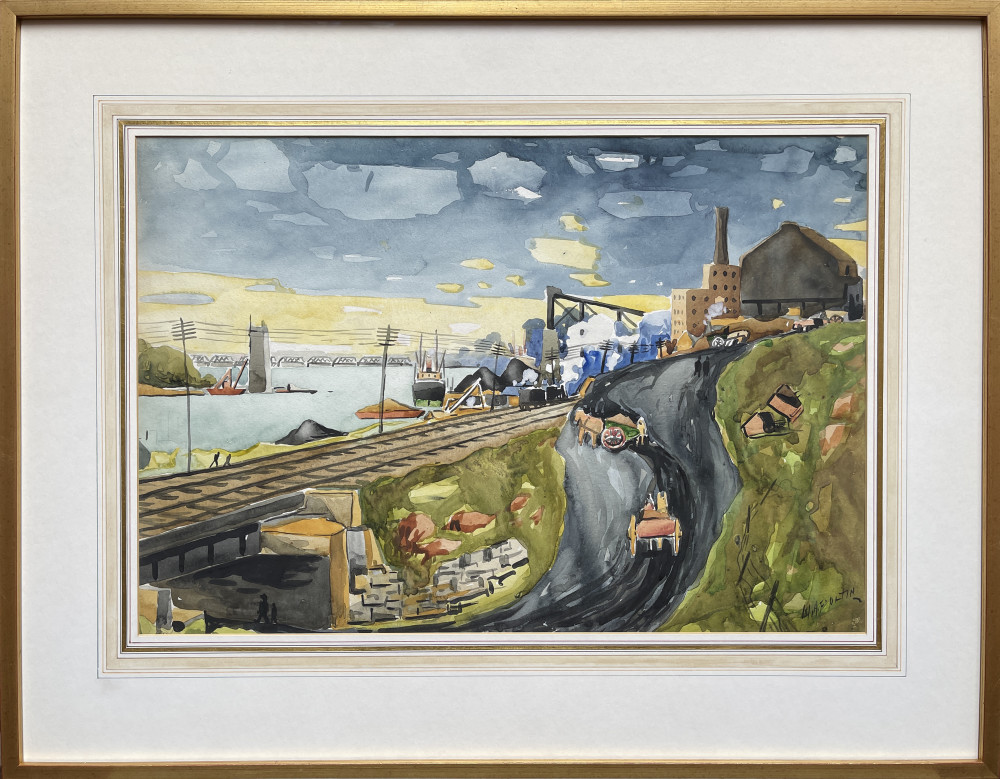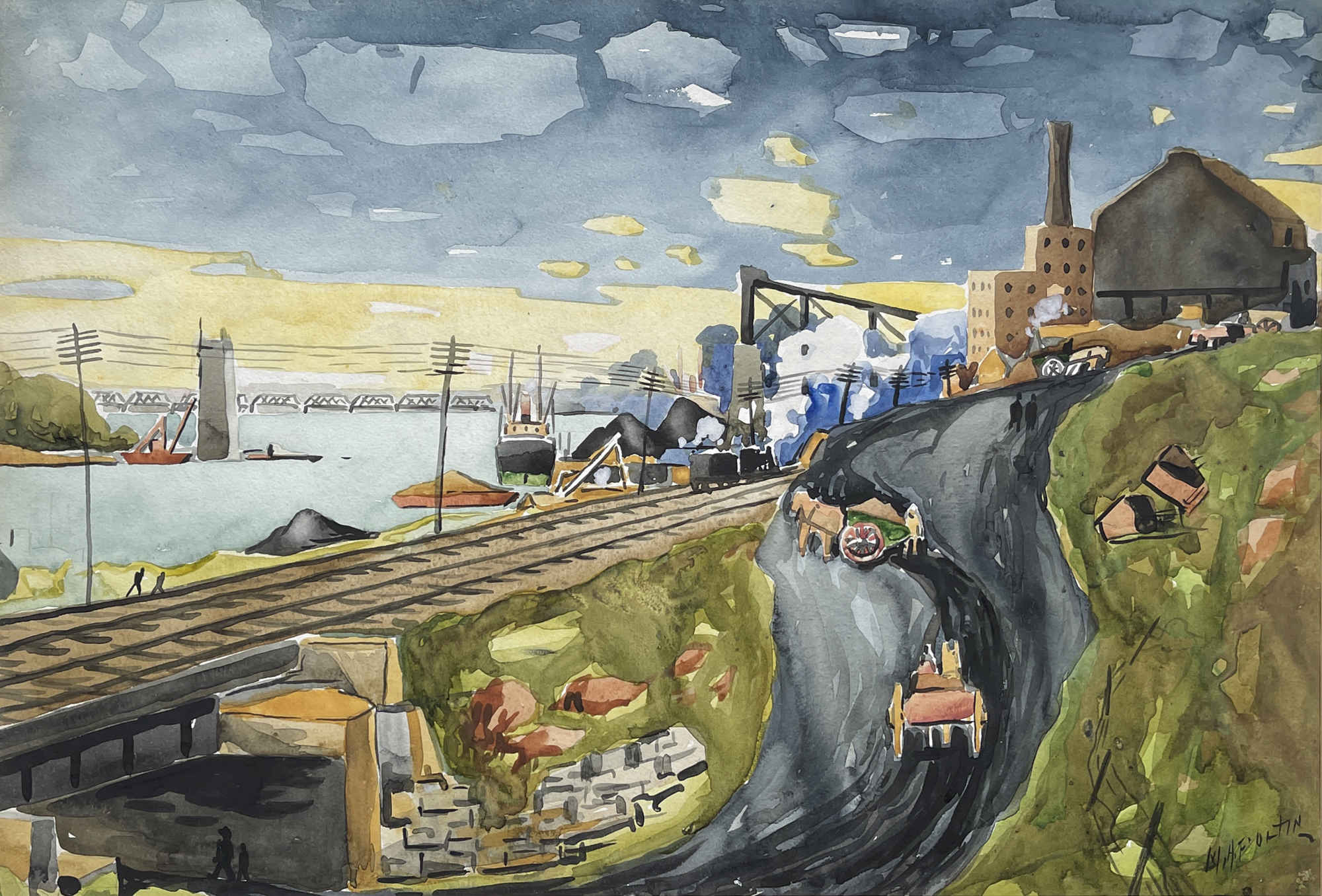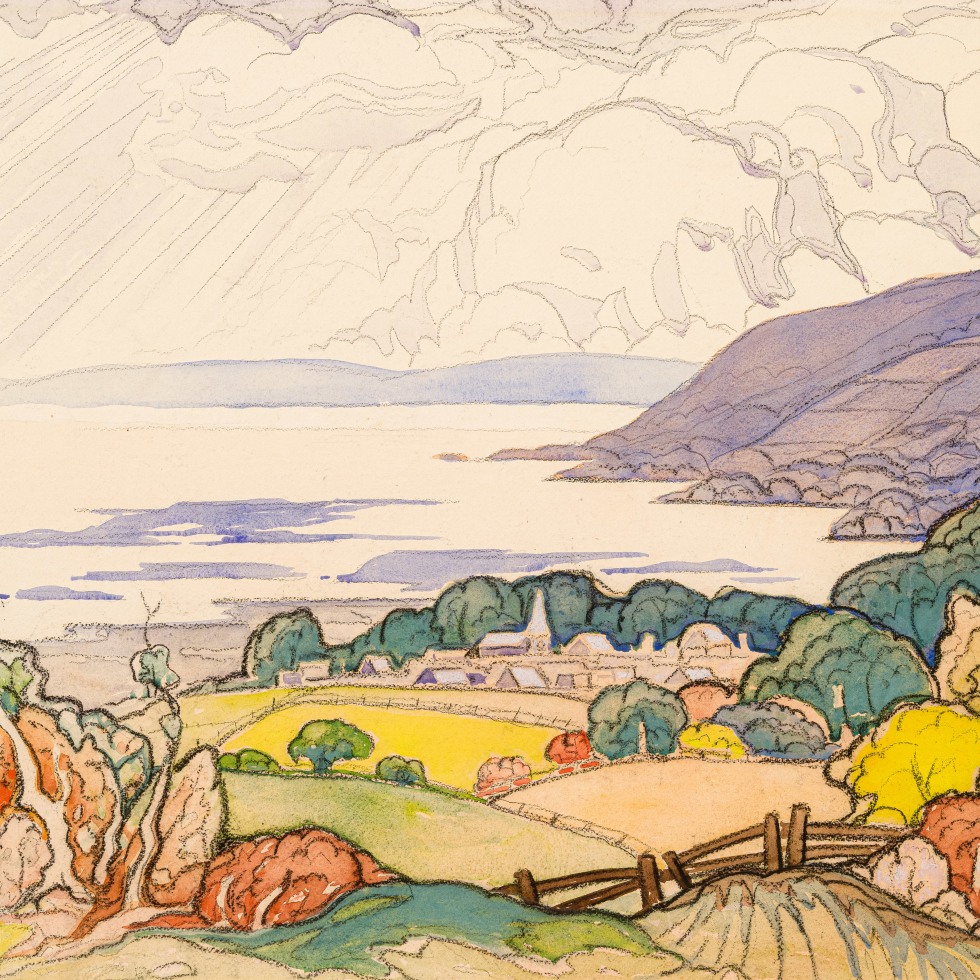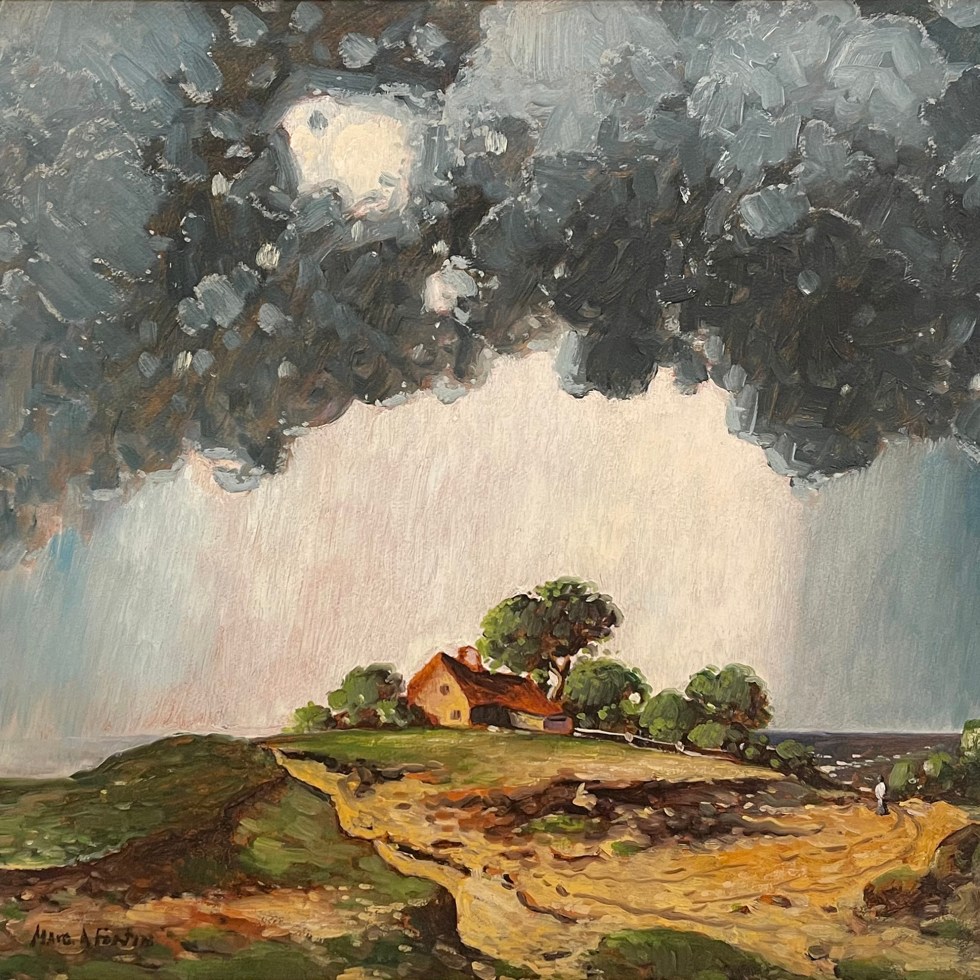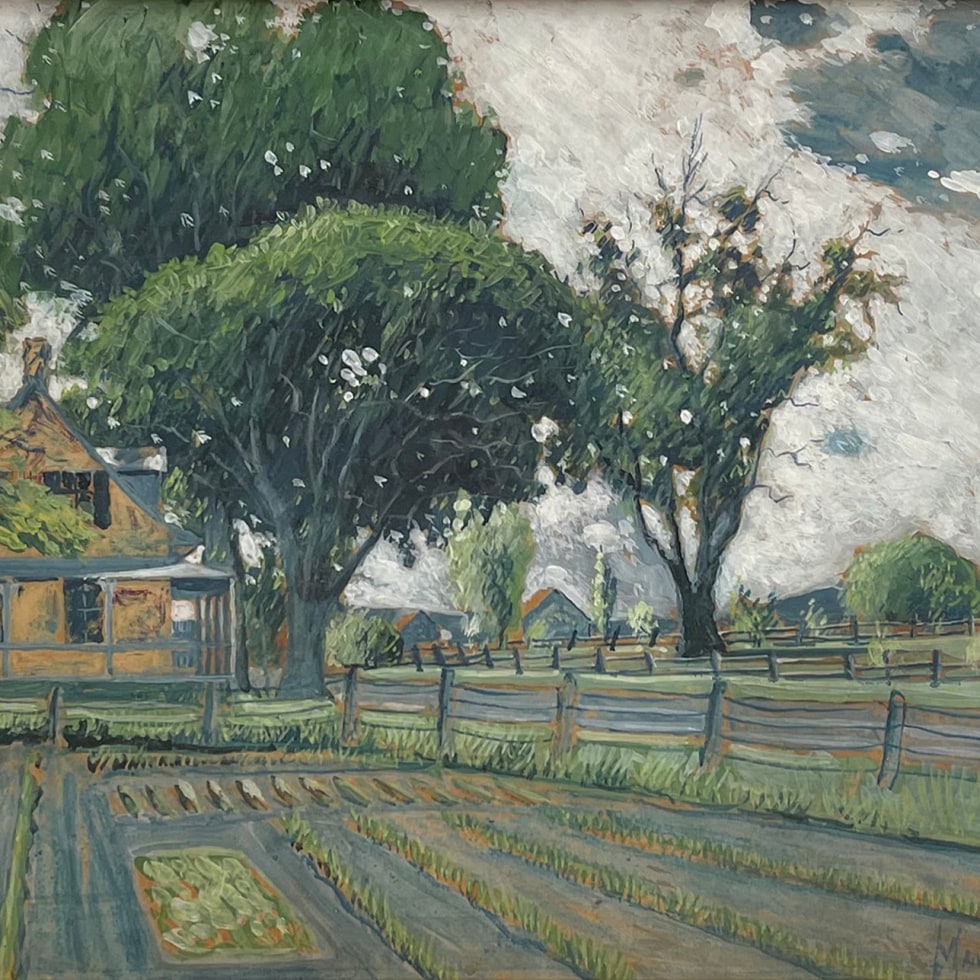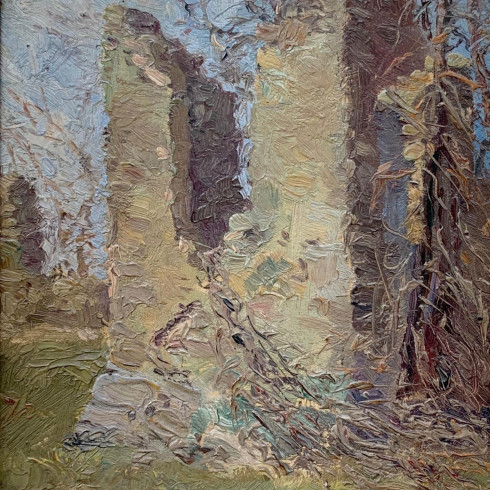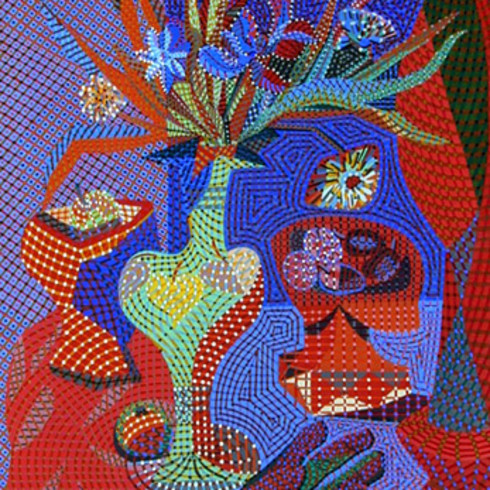Le port (Hochelaga, the Jacques-Cartier Bridge under construction), 1927 (circa)
Watercolour
38.1 x 55.9 cm
15 x 22 in
15 x 22 in
This painting is available to view at our Montreal gallery.
$17,000
Inscriptions
signed, 'M.A. Fortin' (lower right); titled and signed, 'le Port / Fortin' (verso, lower left)Provenance
Galerie Bernard Desroches, MontrealPrivate collection, Montreal.
“Le Port” is a particularly fine composition by the master. Fortin’s poetry with paint is achieved in part with the exaggerated scale and proportions he recreates. It is described in a bold palette and fluidity of brushwork that shows Fortin’s extraordinary ability in the medium of watercolour. His accomplishment in both watercolour and oils is a mastery shared by only a limited and elite number of Canadian artists including David Milne, Franklin Carmichael and Molly Lamb Bobak. In the important study led by the Musée national des beaux-arts du Québec, “Marc-Aurèle Fortin: The Experience of Colour”, led by Michele Grandbois, in her mention that Ontario museums, the National Gallery of Canada and then the Art Gallery of Toronto, which bought watercolours by Fortin in 1930 and 1935 respectively, were the first museums to buy Fortins. She comments that, “They recognized his talent in watercolour before his talent as an oil painter, and consecrated his urban scenes before his rural landscapes”. (1)
The area of Hochelaga was a preferred area for Fortin to paint from the mid 1920s. In the years when Fortin painted this watercolour he was living on Notre Dame, moving between a few addresses, but generally in the area many would be familiar with of Jacques Cartier Square. Fortin is often quoted about his habit when working in the Hochelaga area of positioning himself on elevated ground. As he was to comment, turning in any direction provided him outstanding composition to his interest.
“I went to sit in the same place at least a hundred times, on higher ground, above the railways, from where I could see all of Hochelaga, the steeples of the Nativity [Church of the Nativity of the Blessed Virgin of Hochelaga] and of François-Xavier, all the way to the Church of Longueuil steeple. There, I would paint, and all I had to do was pivot... At every turn, there was a watercolour.” (2)
“The Montreal neighbourhood of Hochelaga is a crucible among thousands across North America. Hochelaga is enclosed within a triangle flanked by the St. Lawrence River to the south and to the north, by the railway; Fortin therefore has a vantage point on a kind of slow-motion battlefield traversed daily by the ships in the port and by rail convoys.” (3)
Guy Robert writes that in the day Fortin would walk down to the tracks and amble along them eastward.
“Along the train tracks, it is still the countryside, with village remains: haywagons, tumbrels, ploughed fields, cows…” (4)
The burgeoning community of Hochelaga itself being built up with new factories and housing for the influx of new citizens relocating from the countryside to the city, views across the river toward the South shore of the St Lawrence, and of course views of the port (see also our other Marc-Aurele Fortin watercolour view of the port).
In our watercolour, titled with characteristic simplicity by Fortin “Le Port”, the view is likely just below Fortin’s perch described previously, conceivably in the general area above where what was and has been recreated in recent years, Bellerive Park looking west toward the setting sun, which includes vestiges of traditional transportation, horse-drawn carts, juxtaposed with the CPR railway tracks, carts filled with coal, a ship in the port and an often painted Jacques Cartier Bridge under construction. The industrial activity, presumably steam, is accentuated by Fortin’s cloud-like imagery in front of the existing bridge structure. The bridge footing on the left just above centre is perhaps at the base of what was then Ile Ronde, annexed to Ile Ste. Helene for Expo 67 and became the amusement area familiarly known as La Ronde. The bridge itself is symbolic of a need for better access by cars and trucks, many emanating from the United States, to the Island of Montreal from the South Shore, than was provided by the two lane Victoria Bridge implied in the distance. All this transpires under a sky the likes of which is unique to Fortin. Originally called The Harbour Bridge, The Victoria Bridge, “was the crowning achievement of some twenty years of road development and an integral part of the automobile revolution.” (5)
____________________________
Footnote:
1. Marc-Aurèle Fortin and Michelle Grandbois, Marc-Aurèle Fortin : the experience of colour (Québec: Musée National Des Beaux-Arts Du Québec, 2011), 110
2. Fortin, Marc-Aurèle. Interview with René Buisson. March 1966. As quoted in Guy Robert, Marc-Aurèle Fortin: l’homme à l’œuvre (Montréal: Stanké, 1976), 122
3. Guy Robert, Marc-Aurèle Fortin: l’homme à l’œuvre (Montréal: Stanké, 1976), 125
4. Ibid.
5. Isabelle Gournay and France Vanlaethem, Montreal Metropolis, 1880-1930 (Toronto: Canadian Centre For Architecture, 1998), 56
The area of Hochelaga was a preferred area for Fortin to paint from the mid 1920s. In the years when Fortin painted this watercolour he was living on Notre Dame, moving between a few addresses, but generally in the area many would be familiar with of Jacques Cartier Square. Fortin is often quoted about his habit when working in the Hochelaga area of positioning himself on elevated ground. As he was to comment, turning in any direction provided him outstanding composition to his interest.
“I went to sit in the same place at least a hundred times, on higher ground, above the railways, from where I could see all of Hochelaga, the steeples of the Nativity [Church of the Nativity of the Blessed Virgin of Hochelaga] and of François-Xavier, all the way to the Church of Longueuil steeple. There, I would paint, and all I had to do was pivot... At every turn, there was a watercolour.” (2)
“The Montreal neighbourhood of Hochelaga is a crucible among thousands across North America. Hochelaga is enclosed within a triangle flanked by the St. Lawrence River to the south and to the north, by the railway; Fortin therefore has a vantage point on a kind of slow-motion battlefield traversed daily by the ships in the port and by rail convoys.” (3)
Guy Robert writes that in the day Fortin would walk down to the tracks and amble along them eastward.
“Along the train tracks, it is still the countryside, with village remains: haywagons, tumbrels, ploughed fields, cows…” (4)
The burgeoning community of Hochelaga itself being built up with new factories and housing for the influx of new citizens relocating from the countryside to the city, views across the river toward the South shore of the St Lawrence, and of course views of the port (see also our other Marc-Aurele Fortin watercolour view of the port).
In our watercolour, titled with characteristic simplicity by Fortin “Le Port”, the view is likely just below Fortin’s perch described previously, conceivably in the general area above where what was and has been recreated in recent years, Bellerive Park looking west toward the setting sun, which includes vestiges of traditional transportation, horse-drawn carts, juxtaposed with the CPR railway tracks, carts filled with coal, a ship in the port and an often painted Jacques Cartier Bridge under construction. The industrial activity, presumably steam, is accentuated by Fortin’s cloud-like imagery in front of the existing bridge structure. The bridge footing on the left just above centre is perhaps at the base of what was then Ile Ronde, annexed to Ile Ste. Helene for Expo 67 and became the amusement area familiarly known as La Ronde. The bridge itself is symbolic of a need for better access by cars and trucks, many emanating from the United States, to the Island of Montreal from the South Shore, than was provided by the two lane Victoria Bridge implied in the distance. All this transpires under a sky the likes of which is unique to Fortin. Originally called The Harbour Bridge, The Victoria Bridge, “was the crowning achievement of some twenty years of road development and an integral part of the automobile revolution.” (5)
____________________________
Footnote:
1. Marc-Aurèle Fortin and Michelle Grandbois, Marc-Aurèle Fortin : the experience of colour (Québec: Musée National Des Beaux-Arts Du Québec, 2011), 110
2. Fortin, Marc-Aurèle. Interview with René Buisson. March 1966. As quoted in Guy Robert, Marc-Aurèle Fortin: l’homme à l’œuvre (Montréal: Stanké, 1976), 122
3. Guy Robert, Marc-Aurèle Fortin: l’homme à l’œuvre (Montréal: Stanké, 1976), 125
4. Ibid.
5. Isabelle Gournay and France Vanlaethem, Montreal Metropolis, 1880-1930 (Toronto: Canadian Centre For Architecture, 1998), 56



